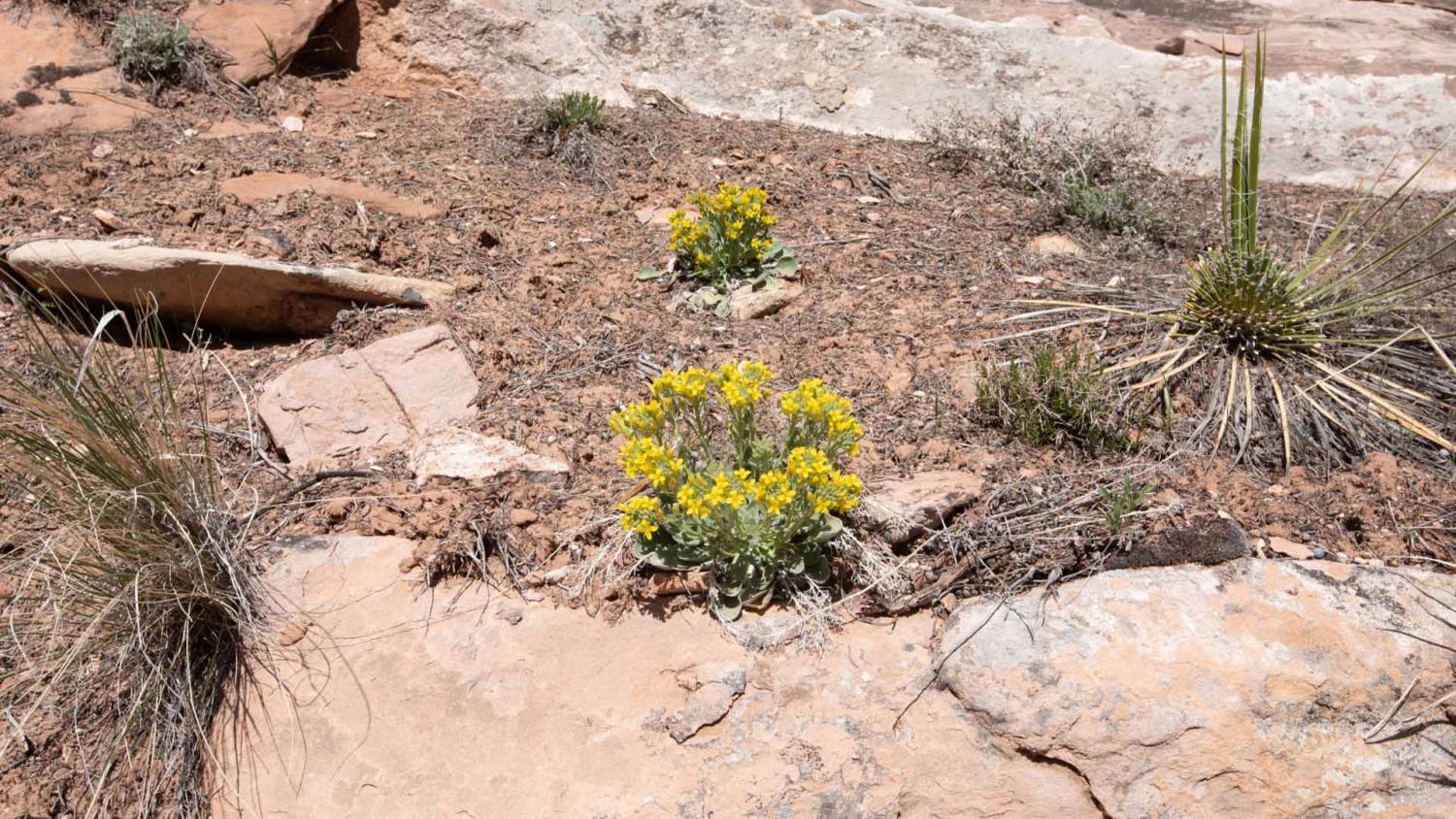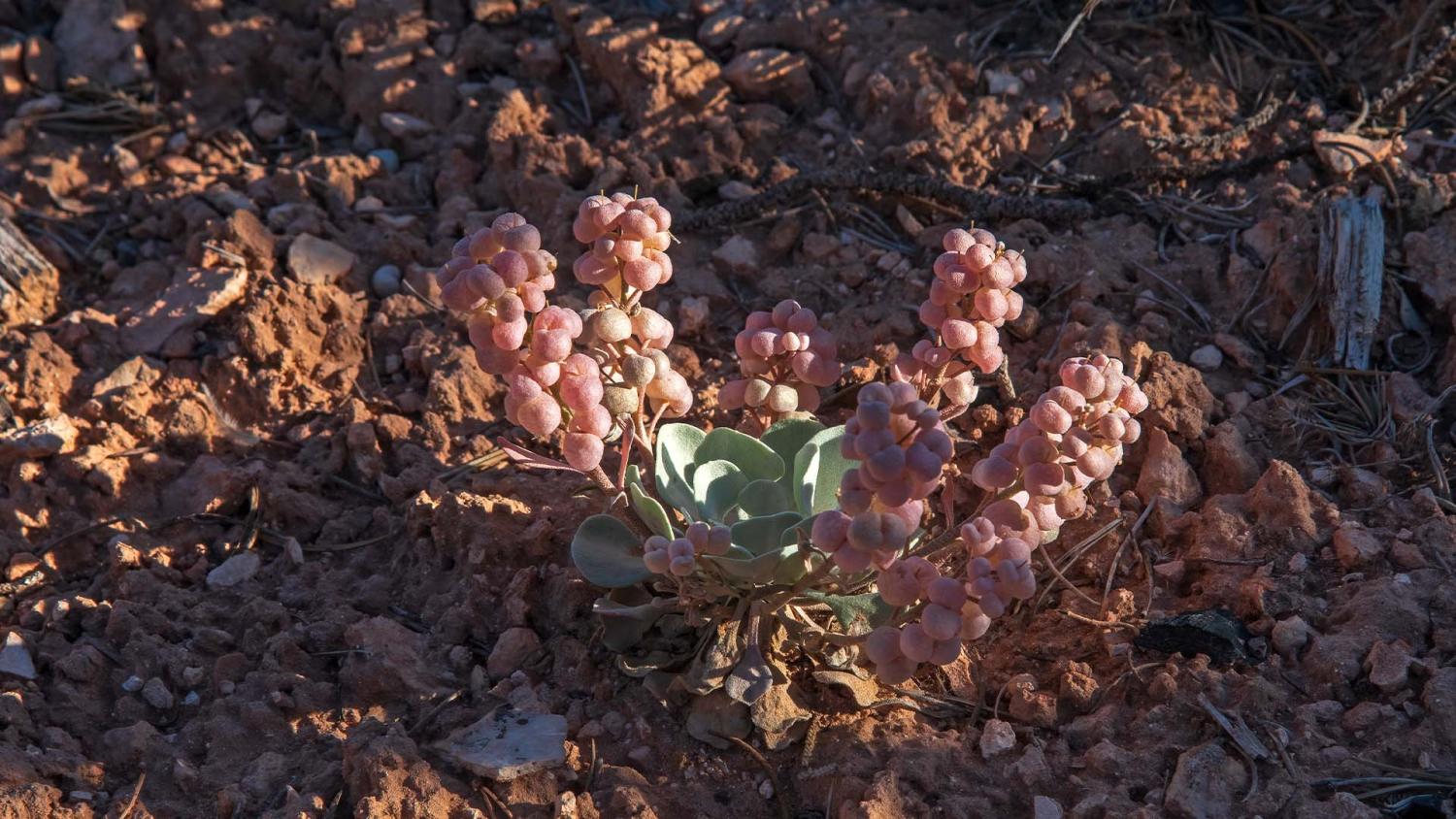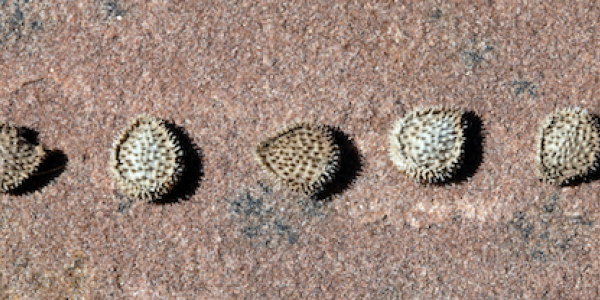Of the genus Physaria, pretty wildflowers, 24 species grow in Colorado. Ten of 24 species are endemic to Colorado, meaning they live nowhere else
As I turned over in my sleeping bag, I noticed that the stars had faded and the sky had a bright red glow. I grabbed the camera, caught the sunrise, then looked around to see what was stirring.
A shaft of sunlight making its way through pinyon pines and junipers isolated a double bladderpod, Physaria acutifolia, and highlighted its pink seed pods. As the seed pods mature, their colors change, starting with green but changing to yellow, then pink, then purple, and finally drying to grey or white. This species is one of the earliest plants to flower on the Colorado Plateau and is the most common Physaria in the region. P. acutifolia is relatively widespread, with populations in Colorado, Utah, Arizona, New Mexico and Wyoming, and just a few populations in Idaho and Montana.

Double bladderpods flowering. Image by Jeff Mitton.
Physaria is Greek for bladder, and acutifolia refers to leaves with sharp edges. Common names for species in this genus are twinpod or bladderpod, referring to the forms of the didymous seed pods, shaped like two balloons pressed together. In medical jargon, didymous refers to testicles, providing insight into the forms of two species, P. didymocarpa and P. scrotoformis.
Physaria is a mustard, one genus in the Family Brassicaceae, which has a total of 374 genera. But Physaria can be distinguished from the other 373 genera by the form of its trichomes, minute appendages projecting from the epidermal cells of leaves and shoots.
The common form in the mustards is dendritic, meaning they look like trees, with just a few branches. In sharp contrast, all of the Physaria have stellate or star-shaped trichomes. Each epidermal cell has one trichome, but it branches profusely, and the branches grow just above and parallel to the epidermis.
Al Schneider, in SouthwestColoradoWildflowers.com, describes the trichomes in Physaria this way "the star-burst pattern of the hairs make the leaf appear to be covered by thousands of minute sea anemones." Trichomes have many functions, but Physaria's stellate trichomes are thought to protect leaves from the desiccation and bright sunlight of desert and alpine environments.
Abigail Mazie and David Baum explored the evolution of stellate trichomes in Physaria with analyses of BLT, a gene that appears to influence trichome branching in mustards. Analyses of DNA sequence evolution found evidence of strong natural selection on BLT in Physaria. They could even determine that selection was strong in the species that first expressed stellate trichomes, but they also noted that selection continues today in Physaria species most recently evolved. Stellate trichomes are a very convenient character to identify species of the genus Physaria, and in addition, the trichomes appear to have continuing importance in adapting species to their environments.
Currently, 106 Physaria species have been described, and 24 species are in Colorado. What is striking is how many are endemic, meaning they live nowhere else. Of the 24 species in Colorado, ten are endemic, and in contrast to the widespread P. acutifolia, many species have tiny geographic ranges. A few examples follow.
Bell's twinpod, P. bellii, is adapted to Niobrara and Pierre shales, although it is found on a few granite substrates. Its entire distribution is between Fort Collins and Ken-Caryl Ranch Natural Area in Denver. Most of its populations are just dots on a map of Boulder County. P. bellii puts on a bright floral display against dark shale on the outcrops at the intersection of Colorado 36 and Neva Road.

Double bladderpod's seed capsules catch early sunlight. Image by Mitton.
The Piceance Basin, in northwestern Colorado, is known for oil, gas and oil shale, but it also contains the entire ranges for two species, both called Dudley Bluffs bladderpod, P. congesta and P. obcordata. Both occur only on the white shale outcrops of the Green River Formation. P. congesta has seven known populations, and P. obcordata has 10 populations.
West silver bladderpod, P. scrotiformis, is a Colorado endemic. Furthermore, one could also say that it is an endemic of the Weminuche Wilderness Area, where it grows on limestone foundations at high elevations.
Physaria alpina is endemic to high alpine areas in northeastern Gunnison Basin and the Mosquito Range in Colorado. Twelve populations are known, but only four were evaluated to have good or excellent viability and over 1,000 individuals. One report estimates that P. alpina occupies only 187 acres.
These examples of tiny distributions are just a sample of the total. But it is sufficient to convince me that species in the genus Physaria have a genetic predisposition to establish populations on sites described as barren, with demanding if not poisonous soils, and adapt to them so quickly that the adapted populations are reproductively isolated.
However, I was unable to find any phylogenetic studies that used DNA data to date the ages of these species. Perhaps they are very young, or perhaps, once adapted to their barren sites, the population lineages linger, with little competition from other species. This is a fascinating puzzle that can be solved with genetic data.
Did you enjoy this article? Subcribe to our newsletter. Passionate about Ecology and Evolutionary Biology? Show your support.



